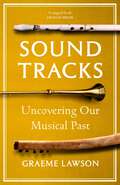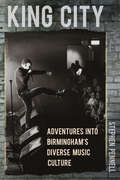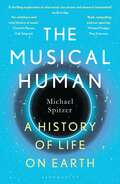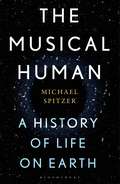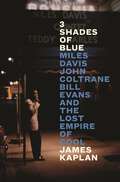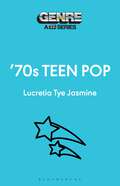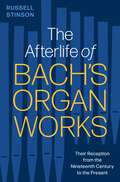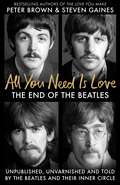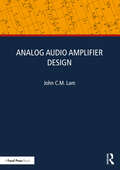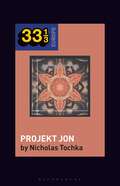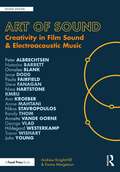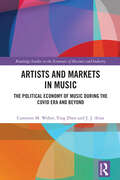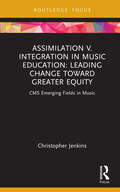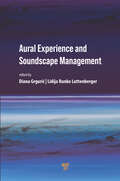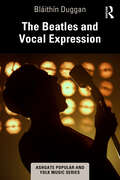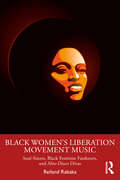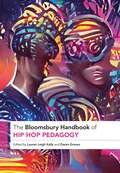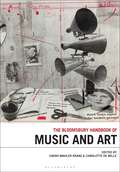- Table View
- List View
Sound Tracks: Uncovering Our Musical Past
by Graeme LawsonA transporting voyage of archaeological discovery: Sound Tracks unearths instruments from around the world and across time, releasing the past's musical secrets for the first time. ‘A thrilling journey into the sonic richness of human experience’ PHILIP BALL, author of The Music Instinct‘A magical book’ FRANCIS PRYOR, author of Britain BCFrom the present day back to the dawn of time, from dark caves and murky swamps to open deserts and ocean depths, here is the history of humankind's relationship with music in fifty detective stories.We see a child’s delight in Peru in AD 700, playing with a water-filled pot that chirps like a bird; we shiver with a lonely soldier sending trumpet signals to the next watchtower on Hadrian's Wall; we sway to the stately rhythms of the 64 bells buried in a tomb in China in the 5th century BC. And on this grand tour, we learn that music is part of what makes us human – a way of commemorating our pasts, communicating with others and shaping our lives.Brimming with astonishing insights, Sound Tracks provides an enthralling alternative history of humanity in which the silences of the past are filled with a glorious treasure hoard of vanished sounds and voices.‘Piles revelation upon revelation to shed a completely new perspective on the tools we use for making music’ NORMAN LEBRECHT, author of Why Beethoven‘Lawson has brilliantly conjured up the sounds of 30,000 years of human history’ DAVID ABULAFIA, Professor Emeritus of Mediterranean History
King City: Adventures into Birmingham's Diverse Music Culture
by Stephen PennellBirmingham has a tradition of individualism and experimentation, giving rise to a fragmented but innovative culture. This applies to the city’s contemporary music scene just as it does to the rest of its cultural heritage, which explains why the Birmingham sound is hard to define. Whereas other cities are known for a certain sound, this city celebrates its diversity. In this new decade, the plethora of exciting indie bands, sick rappers and emotive singer-songwriters are surrounded by a collective of DJs, producers, promoters, venues, bloggers and vloggers who promote them. There’s an agglomeration building, coalescing around the Birmingham Music Awards, whose mission is to amplify this uprising to the world. In this book, Stephen Pennell’s reviews and musings shine a light on Birmingham’s finest up-and-coming performers playing the city’s most iconic venues, taking us on a unique journey around Birmingham’s music scene.
The Musical Human: A History of Life on Earth
by Michael Spitzer'Michael Spitzer has pulled off the impossible: a Guns, Germs and Steel for music' Daniel Levitin 165 million years ago saw the birth of rhythm.66 million years ago was the first melody.40 thousand years ago Homo sapiens created the first musical instrument.Today music fills our lives. How we have created, performed and listened to this music throughout history has defined what our species is and how we understand who we are. Yet music is an overlooked part of our origin story. The Musical Human takes us on an exhilarating journey across the ages – from Bach to BTS and back – to explore the vibrant relationship between music and the human species. With insights from a wealth of disciplines, world-leading musicologist Michael Spitzer renders a global history of music on the widest possible canvas, looking at music in our everyday lives; music in world history; and music in evolution, from insects to apes, humans to AI. Through this journey we begin to understand how music is central to the distinctly human experiences of cognition, feeling and even biology, both widening and closing the evolutionary gaps between ourselves and animals in surprising ways.The Musical Human boldly puts the case that music is the most important thing we ever did; it is a fundamental part of what makes us human.
The Musical Human: A History of Life on Earth
by Michael Spitzer"Michael Spitzer has pulled off the impossible: a Guns, Germs and Steel for music." --Daniel Levitin A colossal history spanning cultures, time, and space to explore the vibrant relationship between music and the human species.165 million years ago saw the birth of rhythm.66 million years ago was the first melody.40 thousand years ago Homo sapiens created the first musical instrument.Today music fills our lives. How we have created, performed and listened to this music throughout history has defined what our species is and how we understand who we are. Yet music is an overlooked part of our origin story. The Musical Human takes us on an exhilarating journey across the ages – from Bach to BTS and back – to explore the vibrant relationship between music and the human species. With insights from a wealth of disciplines, world-leading musicologist Michael Spitzer renders a global history of music on the widest possible canvas, looking at music in our everyday lives; music in world history; and music in evolution, from insects to apes, humans to AI. Through this journey we begin to understand how music is central to the distinctly human experiences of cognition, feeling and even biology, both widening and closing the evolutionary gaps between ourselves and animals in surprising ways.The Musical Human boldly puts the case that music is the most important thing we ever did; it is a fundamental part of what makes us human.
3 Shades of Blue: Miles Davis, John Coltrane, Bill Evans & The Lost Empire of Cool
by James Kaplan1959 saw Miles Davis, John Coltrane, Bill Evans, and the other members of Miles’s sextet come together to record the seminal jazz album of all time Kind of Blue. 3 Shades of Blue is a magnificent, blended biography on the meandering paths which led Miles, Coltrane and Evans to the mountaintop of 1959 and the aftermath. It’s a book about music, business, race, addiction and the cities that gave jazz its home; from New York and LA to Philadelphia, Chicago and Kansas City. Kaplan meditates on creativity and the great forebears of this golden age who would take the music down strange new paths. Above all, this is a book about three very different men – their struggles, their choices, their tragedies, their greatness. The tapestry of their lives is, in Kaplan’s hands, an American Odyssey, with no direction home.
'70s Teen Pop (Genre: A 33 1/3 Series)
by Lucretia Tye JasmineTeen pop is a sub-genre of popular music marketed to tweens and teens. Its melodic yearning and veneer of sincerity appeal to an emerging romantic eroticism and autonomy. But tweens and teens buy music that isn't primarily marketed to them, too. Teen pop encompasses several kinds of musical styles, not limiting itself to just one-teen pop wants to play. During the 1970s, teen pop sometimes worked subversively, challenging the status quo it seemed to represent. Male pop stars such as David Cassidy were shown suggestively in popular magazines and female pop stars such as Cher had their own TV shows. Teen magazines, pin-ups, comics, films, and TV programs provided luscious visual stereo, promoting fashion styles, lingo, and dance moves, signaling individual identity but also community. The music provided a way for young people to believe they had something all their own, an authenticity experimenting with sexuality and social conduct, all dressed up in glitter and satin, blue jeans and boom boxes, torn fishnets and safety pins and, magically, their dreams. Cartoon pop and made-for-TV bands! Bubblegum pop! Glam! Hip hop! Hard rock and pop rock and stadium rock! Punk! Disco! Teen pop reinforced aspects of the counterculture it absorbed as the music kept playing-and playing back.Although it's very difficult to attain and maintain social progress and play it forward-there are so many tragedies-'70s Teen Pop examines how liberation and a true counterculture can be possible through music.
The Afterlife of Bach's Organ Works: Their Reception from the Nineteenth Century to the Present
by Russell StinsonThe music of J. S. Bach continues to be revered and celebrated centuries after his death. Its timelessness can be attributed to masterful musical engineering combined with profound expressivity. In other words, Bach's unique art may represent the pinnacle of contrapuntal technique, but it is just as amazing for its depth of emotion. Bach's compositions remain an indispensable part of the classical-music canon today. The Afterlife of Bach's Organ Works explores the critical impact made on posterity by Bach's organ music. It concerns a diverse group of musicians and non-musicians alike--some famous, some forgotten--who in one way or another became champions of these compositions. These individuals performed the music; edited it for publication; promoted it by means of books, articles, and reviews; transcribed it for other media; taught it to their pupils; shared it with their family and friends; and incorporated it into the soundtracks of their motion pictures. They ensured its "afterlife." In five chapters, organist and Bach expert Russell Stinson traces the historical afterlife of Bach's organ music from the early nineteenth century--the era of the so-called Bach revival--to the present day. Engagingly written and containing a wealth of information previously unavailable in English, the book is a history of performance practice, an aesthetic history of musical taste, and a social history. Each chapter tells the story of how and why Bach's organ works have stood the test of time.
All You Need Is Love: The End of the Beatles - An Oral History by Those Who Were There
by Steven Gaines Peter Brown'I can think of no one better placed to tell the story behind The Beatles than Peter Brown.' -Pattie Boyd Harrison'A revealing oral history of the forces that spurred the band's breakup... drawing from a trove of never before published conversations. Beatles fans will be impatient to get their hands on this.' -Publishers Weekly'**** A gossipy, insider oral history' -MOJO magazineAll You Need is Love is a ground-breaking oral history of the Beatles and how it all came to an end. Based on never-before-published or heard interviews with Paul McCartney, Yoko Ono, George Harrison, Ringo Starr, and their families, friends, and business associates, this is a landmark book, containing stunning new revelations, about the biggest band the world has ever seen.In 1980-1981 former COO of Apple Corp, Peter Brown and author Steven Gaines interviewed everyone in the Beatles' inner circle and included a small portion of the transcripts in their international bestselling book The Love You Make, which spent four months on the New York Times bestseller list. But left in their archives was a treasure trove of unique and candid interviews that they chose not to publish, until now. A powerful work assembled through honest, intimate, sometimes contradictory and always fascinating testimony, All You Need is Love is a one-of-a-kind insight into the final days, weeks, months and years of the Beatles phenomenon.
Analog Audio Amplifier Design
by John C.M. LamAnalog Audio Amplifier Design introduces all the fundamental principles of analog audio amplifiers, alongside practical circuit design techniques and advanced topics. Covering all the basics of amplifier operation and configuration, as well as high-end audio amplifiers, this is a comprehensive guide with design examples and exercises throughout. With chapters on single-device, operational, multi-stage, voltage buffer, power, line-stage and phono-stage amplifiers, Analog Audio Amplifier Design is a comprehensive and practical introduction that empowers readers to master a range of design techniques. This book also provides a variety of graphs and tables of key amplifying devices and properties of amplifier configurations for easy reference. This is an essential resource for audio professionals and hobbyists interested in audio electronics and audio engineering, as well as students on electrical and audio engineering courses.
Analog Audio Amplifier Design
by John C.M. LamAnalog Audio Amplifier Design introduces all the fundamental principles of analog audio amplifiers, alongside practical circuit design techniques and advanced topics. Covering all the basics of amplifier operation and configuration, as well as high-end audio amplifiers, this is a comprehensive guide with design examples and exercises throughout. With chapters on single-device, operational, multi-stage, voltage buffer, power, line-stage and phono-stage amplifiers, Analog Audio Amplifier Design is a comprehensive and practical introduction that empowers readers to master a range of design techniques. This book also provides a variety of graphs and tables of key amplifying devices and properties of amplifier configurations for easy reference. This is an essential resource for audio professionals and hobbyists interested in audio electronics and audio engineering, as well as students on electrical and audio engineering courses.
Ardit Gjebrea’s Projekt Jon (33 1/3 Europe)
by Professor or Dr. Nicholas TochkaAs market reforms and migration transformed Albania in the early 1990s, Ardit Gjebrea began mixing traditional folk music with world music and Italian pop. The resulting album, Projekt Jon (1997), provided a new model for song-Western and cosmopolitan, yet firmly rooted in the fertile soil of the nation-against a backdrop of deepening political uncertainty about the very future of Albania. The Ionian Project announced itself with the frenetic beating of the daullë and the traditional cries of Albania's highland shepherd. This sprawling collaboration between singer-songwriter Ardit Gjebrea, folk singer Hysni Zela, producer Paul Mazzolini, and a team of crack studio musicians in Italy, had an outsized ambition: to transcend the small postsocialist nation-state's borders, imaginatively crafting through sound a new home in Europe for its citizens. But as Gjebrea prepared to launch Projekt Jon, violence prompted by the collapse of widespread pyramid schemes threatened to tear Albania apart. And for the intellectuals concerned about growing cracks in the symbolic foundations of the Albanian nation-state, the album came to serve as a referendum on the nature of postsocialist citizenship.
Art of Sound: Creativity in Film Sound and Electroacoustic Music (Sound Design)
by Andrew Knight-Hill Emma MargetsonBringing together a diverse group of world leading professionals across Post-Production Film Sound and Electroacoustic Music, Art of Sound explores the creative principles that underpin how sonic practitioners act to compose, tell stories, make us feel, and communicate via sound. Revealing new understandings through analysis of interdisciplinary exchanges and interviews, this book investigates questions of aesthetics, perception, and interpretation, unveiling opportunities for a greater appreciation of the artistry in sound practice which underpins both experimental electronic music and the world’s leading film and television productions. It argues that we can better understand and appreciate the creative act if we regard it as a constantly unfolding process of inspiration, material action, and reflection. In contrast to traditional notions, which imagine outputs as developed to reflect a preconceived creative vision, our approach recognises that the output is always emerging as the practitioner flows with their materials in search of their solution, constantly negotiating the rich networks of potential. This enables us to better celebrate the reality of the creative process, de-centring technologies and universal rules, and potentially opening up the ways in which we think about sonic practices to embrace more diverse ideas and approaches. Art of Sound provides insight into the latest developments and approaches to sound and image practice for composers, filmmakers, directors, scholars, producers, sound designers, sound editors, sound mixers, and students who are interested in understanding the creative potential of sound.
Art of Sound: Creativity in Film Sound and Electroacoustic Music (Sound Design)
by Andrew Knight-Hill Emma MargetsonBringing together a diverse group of world leading professionals across Post-Production Film Sound and Electroacoustic Music, Art of Sound explores the creative principles that underpin how sonic practitioners act to compose, tell stories, make us feel, and communicate via sound. Revealing new understandings through analysis of interdisciplinary exchanges and interviews, this book investigates questions of aesthetics, perception, and interpretation, unveiling opportunities for a greater appreciation of the artistry in sound practice which underpins both experimental electronic music and the world’s leading film and television productions. It argues that we can better understand and appreciate the creative act if we regard it as a constantly unfolding process of inspiration, material action, and reflection. In contrast to traditional notions, which imagine outputs as developed to reflect a preconceived creative vision, our approach recognises that the output is always emerging as the practitioner flows with their materials in search of their solution, constantly negotiating the rich networks of potential. This enables us to better celebrate the reality of the creative process, de-centring technologies and universal rules, and potentially opening up the ways in which we think about sonic practices to embrace more diverse ideas and approaches. Art of Sound provides insight into the latest developments and approaches to sound and image practice for composers, filmmakers, directors, scholars, producers, sound designers, sound editors, sound mixers, and students who are interested in understanding the creative potential of sound.
Artists and Markets in Music: The Political Economy of Music During the Covid Era and Beyond (Routledge Studies in the Economics of Business and Industry)
by Cameron M. Weber Ying Zhen J.J. AriasThis monograph is an innovative examination of the political economy of music. It integrates original economic theories and empirical research to shed light on the economic and social forces shaping music and society today. Interactive relationships, such as the importance of entrepreneurship, serendipity and authenticity, will be explored in artist subjective determinations of success. In particular, this book deeply explores the mental health of musicians and "creative destruction" during the covid era, copyrights in music markets and an evaluation of the importance of entrepreneurship and brand marketing in the life of musical artists. The monograph contributes empirical research to underexplored areas in the cultural economics of music, such as the proposed musical production function by Samuel Cameron (Routledge 2015) and the concept of distinction in cultural production by Pierre Bourdieu (Routledge 1984, 2010) as uniquely applied with examples from the covid era. Readers will benefit from this easy-to-understand interdisciplinary exploration of the music industry with a focus on the United States and the political economy of music during the covid era. Most cultural economics is focused on Europe and Asia, so this emphasis on the United States will be of interest. This book will be a beneficial reference work for researchers and will find an audience among music professionals and artists. Academics and non-academics, experts and novices interested in music and political economy will also find value in Artists and Markets in Music.
Artists and Markets in Music: The Political Economy of Music During the Covid Era and Beyond (Routledge Studies in the Economics of Business and Industry)
by Cameron M. Weber Ying Zhen J.J. AriasThis monograph is an innovative examination of the political economy of music. It integrates original economic theories and empirical research to shed light on the economic and social forces shaping music and society today. Interactive relationships, such as the importance of entrepreneurship, serendipity and authenticity, will be explored in artist subjective determinations of success. In particular, this book deeply explores the mental health of musicians and "creative destruction" during the covid era, copyrights in music markets and an evaluation of the importance of entrepreneurship and brand marketing in the life of musical artists. The monograph contributes empirical research to underexplored areas in the cultural economics of music, such as the proposed musical production function by Samuel Cameron (Routledge 2015) and the concept of distinction in cultural production by Pierre Bourdieu (Routledge 1984, 2010) as uniquely applied with examples from the covid era. Readers will benefit from this easy-to-understand interdisciplinary exploration of the music industry with a focus on the United States and the political economy of music during the covid era. Most cultural economics is focused on Europe and Asia, so this emphasis on the United States will be of interest. This book will be a beneficial reference work for researchers and will find an audience among music professionals and artists. Academics and non-academics, experts and novices interested in music and political economy will also find value in Artists and Markets in Music.
Assimilation v. Integration in Music Education: Leading Change toward Greater Equity (CMS Emerging Fields in Music)
by Christopher JenkinsAssimilation v. Integration in Music Education engages with an existential question for American conservatories and orchestras: What does it mean to diversify Western classical music? Many institutions have focused solely on diversifying the demography of their participants, but without a deeper conversation about structural oppression in classical music, this approach continues to isolate and exclude students of color. Rooted in the author’s experience working with BIPOC (Black, Indigenous, and People of Color) students at a major American conservatory, this book articulates the issues facing minority students in conservatories and schools of music, going beyond recruitment to address the cultural issues that alienate students. The author argues that the issue of diversity should be approached through the lens of aesthetics, and that the performance and pedagogy of Western classical music must change if a more diverse membership is to thrive in this genre. Reflecting on the author’s experience through the lens of recent critical theory in music education, this volume presents the viewpoints of Black and Latinx music students in their own words. Addressing the impact of racialized aesthetics on the well-being of BIPOC music students, the author shows how students are alienated when attempting to assimilate into conservatory environments and envisions an alternative, integrative approach to conservatory education. Offering a deep dive into the psychological and cultural reasons for the racialization of Western classical music, and potential institutional solutions, this concise book is relevant to performers, students, and institutional leaders.
Assimilation v. Integration in Music Education: Leading Change toward Greater Equity (CMS Emerging Fields in Music)
by Christopher JenkinsAssimilation v. Integration in Music Education engages with an existential question for American conservatories and orchestras: What does it mean to diversify Western classical music? Many institutions have focused solely on diversifying the demography of their participants, but without a deeper conversation about structural oppression in classical music, this approach continues to isolate and exclude students of color. Rooted in the author’s experience working with BIPOC (Black, Indigenous, and People of Color) students at a major American conservatory, this book articulates the issues facing minority students in conservatories and schools of music, going beyond recruitment to address the cultural issues that alienate students. The author argues that the issue of diversity should be approached through the lens of aesthetics, and that the performance and pedagogy of Western classical music must change if a more diverse membership is to thrive in this genre. Reflecting on the author’s experience through the lens of recent critical theory in music education, this volume presents the viewpoints of Black and Latinx music students in their own words. Addressing the impact of racialized aesthetics on the well-being of BIPOC music students, the author shows how students are alienated when attempting to assimilate into conservatory environments and envisions an alternative, integrative approach to conservatory education. Offering a deep dive into the psychological and cultural reasons for the racialization of Western classical music, and potential institutional solutions, this concise book is relevant to performers, students, and institutional leaders.
Aural Experience and Soundscape Management
by Diana Grguri Lidija Runko LuttenbergerSince technological progress is characterized by the dual effects, positive and negative, it is precisely by sustaining the balance between such binaries that ecologically responsible resource management is restored as a solution for excessive human impact on the environment. Sound and music became relevant from the perspective of management, within the meaning of controlling their negative effects on human beings and their environment as well as utilizing them for meeting human needs. This book integrates the fields of technology, humanities, and social sciences and defines the challenges of noise control from the perspective of acoustic ecology. It discusses the concept of acoustic ecology applied to evoke sound and music management and design solutions for well-being. It will be equally useful for students of electrical engineering, music, and economics; equally challenging to those with a particular prior knowledge and practice; and as much as comprehensive and stimulative for those who are barely embarking upon a new adventure.
Aural Experience and Soundscape Management
Since technological progress is characterized by the dual effects, positive and negative, it is precisely by sustaining the balance between such binaries that ecologically responsible resource management is restored as a solution for excessive human impact on the environment. Sound and music became relevant from the perspective of management, within the meaning of controlling their negative effects on human beings and their environment as well as utilizing them for meeting human needs. This book integrates the fields of technology, humanities, and social sciences and defines the challenges of noise control from the perspective of acoustic ecology. It discusses the concept of acoustic ecology applied to evoke sound and music management and design solutions for well-being. It will be equally useful for students of electrical engineering, music, and economics; equally challenging to those with a particular prior knowledge and practice; and as much as comprehensive and stimulative for those who are barely embarking upon a new adventure.
The Beatles and Vocal Expression (Ashgate Popular and Folk Music Series)
by Bláithín DugganThe Beatles and Vocal Expression examines popular song through the topic of paralanguage – a sub-category of nonverbal communication that addresses characteristics of speech that modify meaning and convey emotion. It responds to the general consensus regarding the limitations of Western art music notation to analyse popular song, assesses paralinguistic voice qualities giving rise to expressive tropes within and across songs, and lastly addresses gaps in existing Beatles scholarship. Taking The Beatles’ UK studio albums (1963–1970), paralinguistic voice qualities are examined in relation to concepts, characteristics, metaphors, and functions of paralanguage in vocal performance. Tropes, such as rising and falling intonation on words of woe, have historical connections to performative and conversational techniques. This interdisciplinary analysis is achieved through musicology, sound studies, applied linguistics, and cultural history. The new methodology locates paralinguistic voice qualities in recordings, identifies features, shows functions, and draws aural threads within and across popular songs.
The Beatles and Vocal Expression (Ashgate Popular and Folk Music Series)
by Bláithín DugganThe Beatles and Vocal Expression examines popular song through the topic of paralanguage – a sub-category of nonverbal communication that addresses characteristics of speech that modify meaning and convey emotion. It responds to the general consensus regarding the limitations of Western art music notation to analyse popular song, assesses paralinguistic voice qualities giving rise to expressive tropes within and across songs, and lastly addresses gaps in existing Beatles scholarship. Taking The Beatles’ UK studio albums (1963–1970), paralinguistic voice qualities are examined in relation to concepts, characteristics, metaphors, and functions of paralanguage in vocal performance. Tropes, such as rising and falling intonation on words of woe, have historical connections to performative and conversational techniques. This interdisciplinary analysis is achieved through musicology, sound studies, applied linguistics, and cultural history. The new methodology locates paralinguistic voice qualities in recordings, identifies features, shows functions, and draws aural threads within and across popular songs.
Black Women's Liberation Movement Music: Soul Sisters, Black Feminist Funksters, and Afro-Disco Divas
by Reiland RabakaBlack Women’s Liberation Movement Music argues that the Black Women’s Liberation Movement of the mid-to-late 1960s and 1970s was a unique combination of Black political feminism, Black literary feminism, and Black musical feminism, among other forms of Black feminism. This book critically explores the ways the soundtracks of the Black Women’s Liberation Movement often overlapped with those of other 1960s and 1970s social, political, and cultural movements, such as the Black Power Movement, Women’s Liberation Movement, and Sexual Revolution. The soul, funk, and disco music of the Black Women’s Liberation Movement era is simultaneously interpreted as universalist, feminist (in a general sense), and Black female-focused. This music’s incredible ability to be interpreted in so many different ways speaks to the importance and power of Black women’s music and the fact that it has multiple meanings for a multitude of people. Within the worlds of both Black Popular Movement Studies and Black Popular Music Studies there has been a long-standing tendency to almost exclusively associate Black women’s music of the mid-to-late 1960s and 1970s with the Black male-dominated Black Power Movement or the White female-dominated Women’s Liberation Movement. However, this book reveals that much of the soul, funk, and disco performed by Black women was most often the very popular music of a very unpopular and unsung movement: The Black Women’s Liberation Movement. Black Women’s Liberation Movement Music is an invaluable resource for students, teachers, and researchers of Popular Music Studies, American Studies, African American Studies, Critical Race Studies, Gender Studies, and Sexuality Studies.
Black Women's Liberation Movement Music: Soul Sisters, Black Feminist Funksters, and Afro-Disco Divas
by Reiland RabakaBlack Women’s Liberation Movement Music argues that the Black Women’s Liberation Movement of the mid-to-late 1960s and 1970s was a unique combination of Black political feminism, Black literary feminism, and Black musical feminism, among other forms of Black feminism. This book critically explores the ways the soundtracks of the Black Women’s Liberation Movement often overlapped with those of other 1960s and 1970s social, political, and cultural movements, such as the Black Power Movement, Women’s Liberation Movement, and Sexual Revolution. The soul, funk, and disco music of the Black Women’s Liberation Movement era is simultaneously interpreted as universalist, feminist (in a general sense), and Black female-focused. This music’s incredible ability to be interpreted in so many different ways speaks to the importance and power of Black women’s music and the fact that it has multiple meanings for a multitude of people. Within the worlds of both Black Popular Movement Studies and Black Popular Music Studies there has been a long-standing tendency to almost exclusively associate Black women’s music of the mid-to-late 1960s and 1970s with the Black male-dominated Black Power Movement or the White female-dominated Women’s Liberation Movement. However, this book reveals that much of the soul, funk, and disco performed by Black women was most often the very popular music of a very unpopular and unsung movement: The Black Women’s Liberation Movement. Black Women’s Liberation Movement Music is an invaluable resource for students, teachers, and researchers of Popular Music Studies, American Studies, African American Studies, Critical Race Studies, Gender Studies, and Sexuality Studies.
The Bloomsbury Handbook of Hip Hop Pedagogy (Bloomsbury Handbooks)
by Lauren Leigh Kelly and Daren GravesThe Bloomsbury Handbook of Hip Hop Pedagogy is the first reference work to cover the theory, history, research methodologies, and practice of Hip Hop pedagogy. Including 20 chapters from activist-oriented and community engaged scholars, the handbook provides perspectives and studies from across the world, including Brazil, the Caribbean, Scandinavia, and the USA. Organized into four topical sections focusing on the history and cultural roots of Hip Hop; theories and research methods in Hip Hop pedagogy; and Hip Hop pedagogy in practice, the handbook offers theoretical, analytical, and pedagogical insights emerging across sociology, literacy, school counselling and youth organizing. The chapters reflect the impact of critical Hip Hop pedagogies and Hip Hop-based research for educators and scholars interested in radical, transformative approaches to education. Ultimately, the many voices included in the handbook show that Hip Hop pedagogy is a humanizing and emancipatory approach which is redefining the purposes and practices of education.
The Bloomsbury Handbook of Music and Art (Bloomsbury Handbooks)
by Sarah Mahler Kraaz and Charlotte de MilleThis volume brings together prominent scholars, artists, composers, and directors to present the latest interdisciplinary ideas and projects in the fields of art history, musicology and multi-media practice. Organized around ways of perceiving, experiencing and creating, the book outlines the state of the field through cutting-edge research case studies. For example, how does art-music practice / thinking communicate activist activities? How do socio-economic and environmental problems affect access to heritage? How do contemporary practitioners interpret past works and what global concerns stimulate new works? In each instance, examples of cross or inter-media works are not thought of in isolation but in a global historical context that shows our cultural existence to be complex, conflicted and entwined. For the first time cross-disciplinary collaborations in ethnomusicology-anthropology, ecomusicology-ecoart-ecomuseology and digital humanities for art history, musicology and practice are prioritized in one volume.
